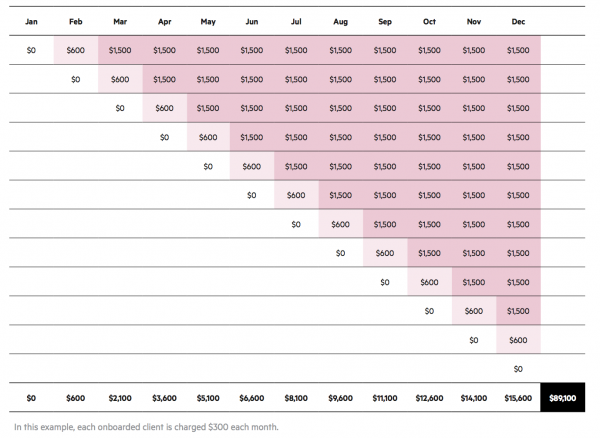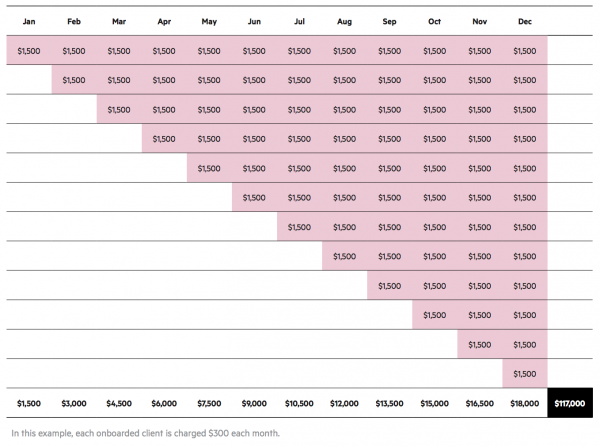Fueling your revenue with better client onboarding

As you improve the efficiency of your firm with an objective of growing your revenue, there's one key process you should be looking at above all others—client onboarding.
Your main objective should be to improve the processes that directly grow your top line—whether that leads to acquiring more clients and onboarding them quicker, or upselling to your current clients with greater success. If you can do this, you will see revenue faster.
If it currently takes you 45 days for client onboarding—to move a client from your first conversation to performing routine work—and you are acquiring 5 new clients a month on average, it means you will see revenue from none of these clients in the first month. By the end of the next month, 2 or 3 may have concluded their onboarding.
As this trend continues, the monthly recurring revenue (MRR) from your new client base will look something like this.

What if you could find a way to reduce the time it takes to onboard clients? Many progressive firms take less than 30 days, while the best in class are nearer to 15. If you can refine your process to onboard clients in this period of time, you will be serving the same number of clients, but realizing revenue from them much sooner. And your monthly recurring revenue would look quite different.

As shown in the two tables above, the difference in monthly recurring revenue is dramatic. If you are taking too long to onboard your clients, there is $27,900 in lost revenue. In reality, you are probably onboarding larger numbers of clients and have a much higher average revenue per client—meaning you could be missing out on significantly more growth to your top line than this example shows.
You do not make money onboarding clients, you make money on the recurring work and tax, so design your processes accordingly. The quicker you can move your clients through onboarding and into this ongoing work, the earlier you will realize revenue.
Onboarding is more about project management than accounting. So if we can bifurcate a lot of the lower tasks and allocate them to lower level people, our project managers can have 10% more time to focus and can take on an extra project.
Find ways to give onboarding staff more time to focus on the more involved, skilled steps of the process. An example of this could be to have one staff member responsible from the time the engagement letter is signed, who reaches out with a welcome email to gather documents. By the time your onboarding managers become involved, they have everything they need and don’t have to waste time chasing things up or searching for information.
Onboarding is one of a number of processes that you should continually be striving to cut down in time, but it is a key one. Reducing the time it takes is not in your interest just from a revenue point of view, it is also about reducing project risk. The longer it takes, the less time you have to provide value to your client—meaning there will be a higher likelihood of cancellation.
Prior to taking an active look into our onboarding, it felt like it took forever, for everyone. Today, we can onboard a new customer within two weeks, We have a clear system that involves multiple team members working in the background to make things as easy possible.
Onboarding is an essential process that impacts your future with every client. The quicker you can implement the process while maintaining your quality and high level of customer service, the quicker you can grow.
This article is an excerpt from Efficiency for growth: the smarter way to fuel your accounting firm's topline. You can download the complete report for free here.